Ming Ding
Hierarchical Federated Learning for Social Network with Mobility
Sep 18, 2025Abstract:Federated Learning (FL) offers a decentralized solution that allows collaborative local model training and global aggregation, thereby protecting data privacy. In conventional FL frameworks, data privacy is typically preserved under the assumption that local data remains absolutely private, whereas the mobility of clients is frequently neglected in explicit modeling. In this paper, we propose a hierarchical federated learning framework based on the social network with mobility namely HFL-SNM that considers both data sharing among clients and their mobility patterns. Under the constraints of limited resources, we formulate a joint optimization problem of resource allocation and client scheduling, which objective is to minimize the energy consumption of clients during the FL process. In social network, we introduce the concepts of Effective Data Coverage Rate and Redundant Data Coverage Rate. We analyze the impact of effective data and redundant data on the model performance through preliminary experiments. We decouple the optimization problem into multiple sub-problems, analyze them based on preliminary experimental results, and propose Dynamic Optimization in Social Network with Mobility (DO-SNM) algorithm. Experimental results demonstrate that our algorithm achieves superior model performance while significantly reducing energy consumption, compared to traditional baseline algorithms.
Assessing GPT Performance in a Proof-Based University-Level Course Under Blind Grading
May 19, 2025


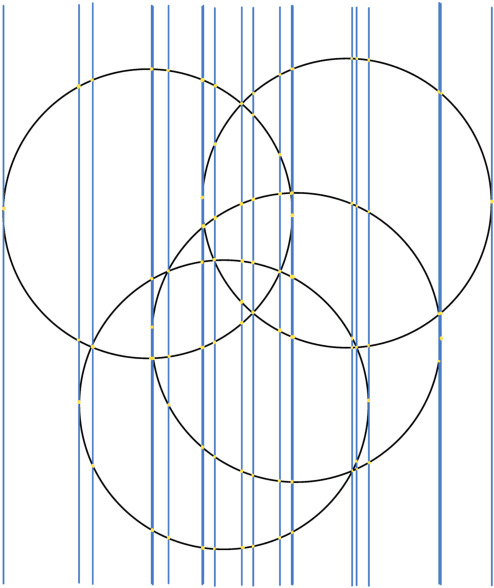
Abstract:As large language models (LLMs) advance, their role in higher education, particularly in free-response problem-solving, requires careful examination. This study assesses the performance of GPT-4o and o1-preview under realistic educational conditions in an undergraduate algorithms course. Anonymous GPT-generated solutions to take-home exams were graded by teaching assistants unaware of their origin. Our analysis examines both coarse-grained performance (scores) and fine-grained reasoning quality (error patterns). Results show that GPT-4o consistently struggles, failing to reach the passing threshold, while o1-preview performs significantly better, surpassing the passing score and even exceeding the student median in certain exercises. However, both models exhibit issues with unjustified claims and misleading arguments. These findings highlight the need for robust assessment strategies and AI-aware grading policies in education.
Privacy Meets Explainability: Managing Confidential Data and Transparency Policies in LLM-Empowered Science
Apr 14, 2025


Abstract:As Large Language Models (LLMs) become integral to scientific workflows, concerns over the confidentiality and ethical handling of confidential data have emerged. This paper explores data exposure risks through LLM-powered scientific tools, which can inadvertently leak confidential information, including intellectual property and proprietary data, from scientists' perspectives. We propose "DataShield", a framework designed to detect confidential data leaks, summarize privacy policies, and visualize data flow, ensuring alignment with organizational policies and procedures. Our approach aims to inform scientists about data handling practices, enabling them to make informed decisions and protect sensitive information. Ongoing user studies with scientists are underway to evaluate the framework's usability, trustworthiness, and effectiveness in tackling real-world privacy challenges.
Multi-Objective Optimization for Privacy-Utility Balance in Differentially Private Federated Learning
Mar 27, 2025Abstract:Federated learning (FL) enables collaborative model training across distributed clients without sharing raw data, making it a promising approach for privacy-preserving machine learning. However, ensuring differential privacy (DP) in FL presents challenges due to the trade-off between model utility and privacy protection. Clipping gradients before aggregation is a common strategy to limit privacy loss, but selecting an optimal clipping norm is non-trivial, as excessively high values compromise privacy, while overly restrictive clipping degrades model performance. In this work, we propose an adaptive clipping mechanism that dynamically adjusts the clipping norm using a multi-objective optimization framework. By integrating privacy and utility considerations into the optimization objective, our approach balances privacy preservation with model accuracy. We theoretically analyze the convergence properties of our method and demonstrate its effectiveness through extensive experiments on MNIST, Fashion-MNIST, and CIFAR-10 datasets. Our results show that adaptive clipping consistently outperforms fixed-clipping baselines, achieving improved accuracy under the same privacy constraints. This work highlights the potential of dynamic clipping strategies to enhance privacy-utility trade-offs in differentially private federated learning.
Adaptive Clipping for Privacy-Preserving Few-Shot Learning: Enhancing Generalization with Limited Data
Mar 27, 2025Abstract:In the era of data-driven machine-learning applications, privacy concerns and the scarcity of labeled data have become paramount challenges. These challenges are particularly pronounced in the domain of few-shot learning, where the ability to learn from limited labeled data is crucial. Privacy-preserving few-shot learning algorithms have emerged as a promising solution to address such pronounced challenges. However, it is well-known that privacy-preserving techniques often lead to a drop in utility due to the fundamental trade-off between data privacy and model performance. To enhance the utility of privacy-preserving few-shot learning methods, we introduce a novel approach called Meta-Clip. This technique is specifically designed for meta-learning algorithms, including Differentially Private (DP) model-agnostic meta-learning, DP-Reptile, and DP-MetaSGD algorithms, with the objective of balancing data privacy preservation with learning capacity maximization. By dynamically adjusting clipping thresholds during the training process, our Adaptive Clipping method provides fine-grained control over the disclosure of sensitive information, mitigating overfitting on small datasets and significantly improving the generalization performance of meta-learning models. Through comprehensive experiments on diverse benchmark datasets, we demonstrate the effectiveness of our approach in minimizing utility degradation, showcasing a superior privacy-utility trade-off compared to existing privacy-preserving techniques. The adoption of Adaptive Clipping represents a substantial step forward in the field of privacy-preserving few-shot learning, empowering the development of secure and accurate models for real-world applications, especially in scenarios where there are limited data availability.
Do Fairness Interventions Come at the Cost of Privacy: Evaluations for Binary Classifiers
Mar 11, 2025Abstract:While in-processing fairness approaches show promise in mitigating biased predictions, their potential impact on privacy leakage remains under-explored. We aim to address this gap by assessing the privacy risks of fairness-enhanced binary classifiers via membership inference attacks (MIAs) and attribute inference attacks (AIAs). Surprisingly, our results reveal that enhancing fairness does not necessarily lead to privacy compromises. For example, these fairness interventions exhibit increased resilience against MIAs and AIAs. This is because fairness interventions tend to remove sensitive information among extracted features and reduce confidence scores for the majority of training data for fairer predictions. However, during the evaluations, we uncover a potential threat mechanism that exploits prediction discrepancies between fair and biased models, leading to advanced attack results for both MIAs and AIAs. This mechanism reveals potent vulnerabilities of fair models and poses significant privacy risks of current fairness methods. Extensive experiments across multiple datasets, attack methods, and representative fairness approaches confirm our findings and demonstrate the efficacy of the uncovered mechanism. Our study exposes the under-explored privacy threats in fairness studies, advocating for thorough evaluations of potential security vulnerabilities before model deployments.
VisionReward: Fine-Grained Multi-Dimensional Human Preference Learning for Image and Video Generation
Dec 30, 2024Abstract:We present a general strategy to aligning visual generation models -- both image and video generation -- with human preference. To start with, we build VisionReward -- a fine-grained and multi-dimensional reward model. We decompose human preferences in images and videos into multiple dimensions, each represented by a series of judgment questions, linearly weighted and summed to an interpretable and accurate score. To address the challenges of video quality assessment, we systematically analyze various dynamic features of videos, which helps VisionReward surpass VideoScore by 17.2% and achieve top performance for video preference prediction. Based on VisionReward, we develop a multi-objective preference learning algorithm that effectively addresses the issue of confounding factors within preference data. Our approach significantly outperforms existing image and video scoring methods on both machine metrics and human evaluation. All code and datasets are provided at https://github.com/THUDM/VisionReward.
From Principles to Practice: A Deep Dive into AI Ethics and Regulations
Dec 06, 2024
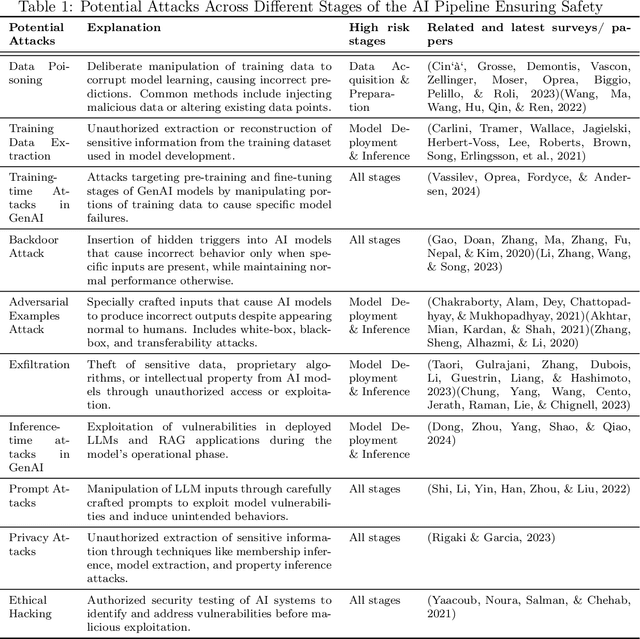
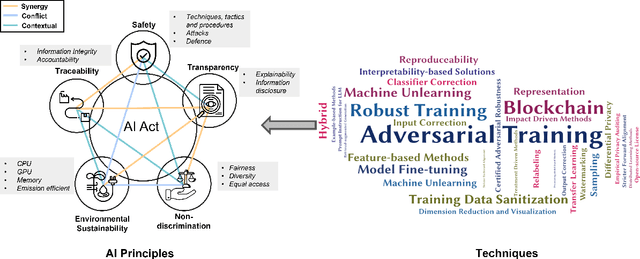

Abstract:In the rapidly evolving domain of Artificial Intelligence (AI), the complex interaction between innovation and regulation has become an emerging focus of our society. Despite tremendous advancements in AI's capabilities to excel in specific tasks and contribute to diverse sectors, establishing a high degree of trust in AI-generated outputs and decisions necessitates meticulous caution and continuous oversight. A broad spectrum of stakeholders, including governmental bodies, private sector corporations, academic institutions, and individuals, have launched significant initiatives. These efforts include developing ethical guidelines for AI and engaging in vibrant discussions on AI ethics, both among AI practitioners and within the broader society. This article thoroughly analyzes the ground-breaking AI regulatory framework proposed by the European Union. It delves into the fundamental ethical principles of safety, transparency, non-discrimination, traceability, and environmental sustainability for AI developments and deployments. Considering the technical efforts and strategies undertaken by academics and industry to uphold these principles, we explore the synergies and conflicts among the five ethical principles. Through this lens, work presents a forward-looking perspective on the future of AI regulations, advocating for a harmonized approach that safeguards societal values while encouraging technological advancement.
Face De-identification: State-of-the-art Methods and Comparative Studies
Nov 15, 2024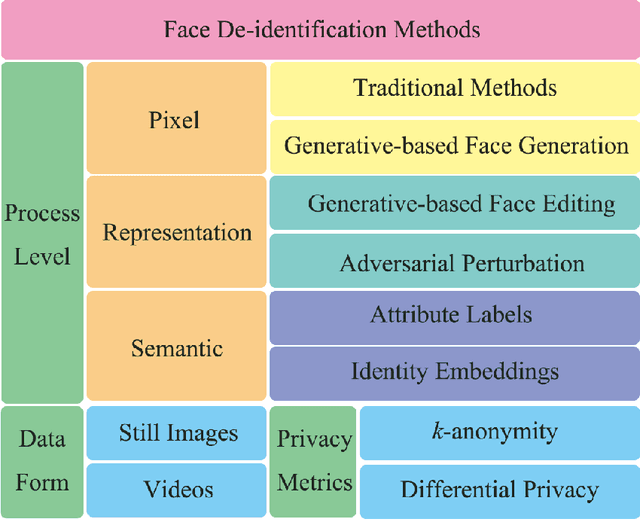
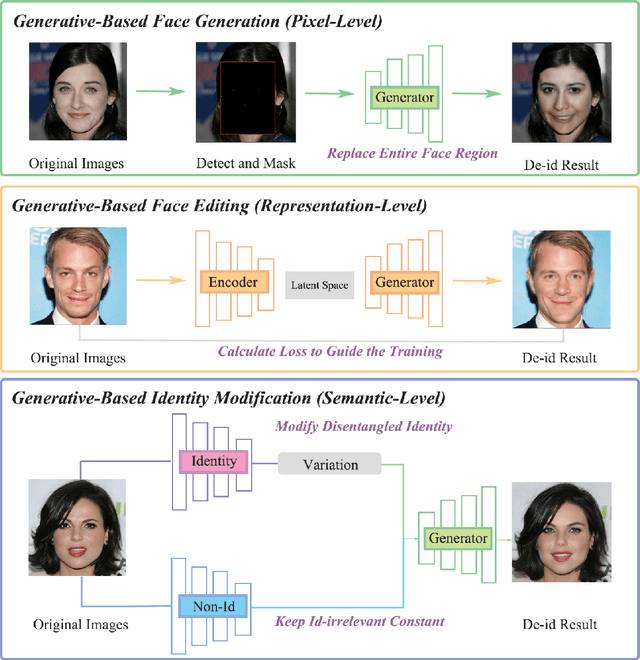
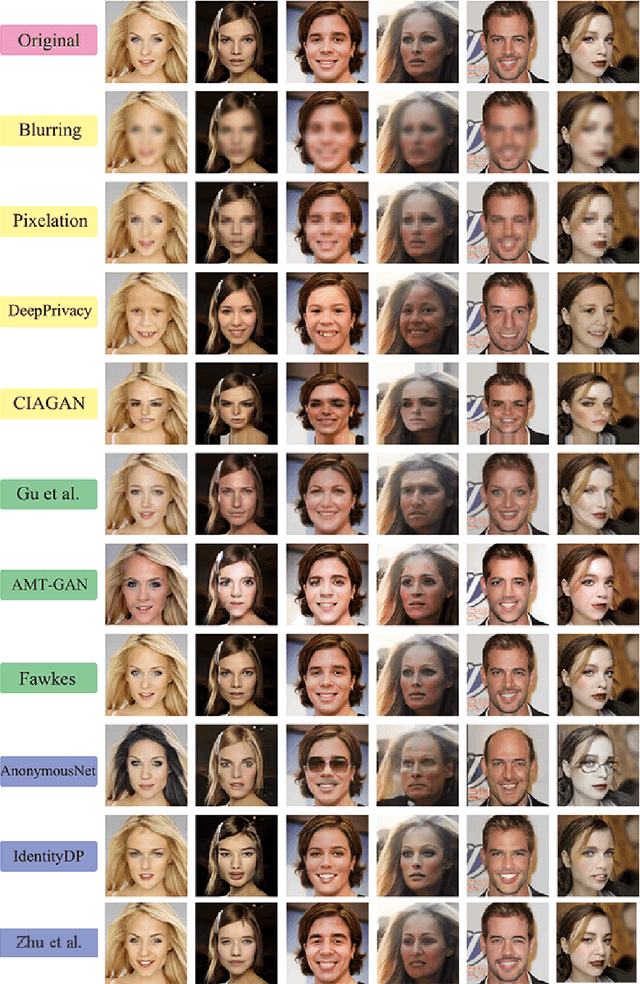
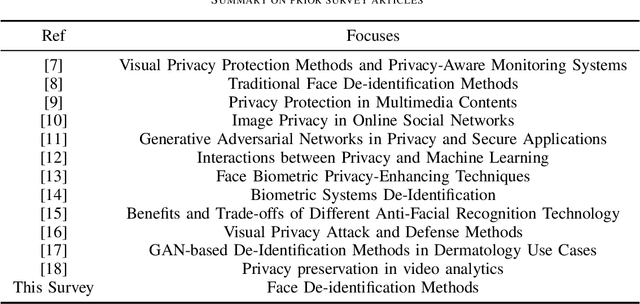
Abstract:The widespread use of image acquisition technologies, along with advances in facial recognition, has raised serious privacy concerns. Face de-identification usually refers to the process of concealing or replacing personal identifiers, which is regarded as an effective means to protect the privacy of facial images. A significant number of methods for face de-identification have been proposed in recent years. In this survey, we provide a comprehensive review of state-of-the-art face de-identification methods, categorized into three levels: pixel-level, representation-level, and semantic-level techniques. We systematically evaluate these methods based on two key criteria, the effectiveness of privacy protection and preservation of image utility, highlighting their advantages and limitations. Our analysis includes qualitative and quantitative comparisons of the main algorithms, demonstrating that deep learning-based approaches, particularly those using Generative Adversarial Networks (GANs) and diffusion models, have achieved significant advancements in balancing privacy and utility. Experimental results reveal that while recent methods demonstrate strong privacy protection, trade-offs remain in visual fidelity and computational complexity. This survey not only summarizes the current landscape but also identifies key challenges and future research directions in face de-identification.
DreamPolish: Domain Score Distillation With Progressive Geometry Generation
Nov 03, 2024



Abstract:We introduce DreamPolish, a text-to-3D generation model that excels in producing refined geometry and high-quality textures. In the geometry construction phase, our approach leverages multiple neural representations to enhance the stability of the synthesis process. Instead of relying solely on a view-conditioned diffusion prior in the novel sampled views, which often leads to undesired artifacts in the geometric surface, we incorporate an additional normal estimator to polish the geometry details, conditioned on viewpoints with varying field-of-views. We propose to add a surface polishing stage with only a few training steps, which can effectively refine the artifacts attributed to limited guidance from previous stages and produce 3D objects with more desirable geometry. The key topic of texture generation using pretrained text-to-image models is to find a suitable domain in the vast latent distribution of these models that contains photorealistic and consistent renderings. In the texture generation phase, we introduce a novel score distillation objective, namely domain score distillation (DSD), to guide neural representations toward such a domain. We draw inspiration from the classifier-free guidance (CFG) in textconditioned image generation tasks and show that CFG and variational distribution guidance represent distinct aspects in gradient guidance and are both imperative domains for the enhancement of texture quality. Extensive experiments show our proposed model can produce 3D assets with polished surfaces and photorealistic textures, outperforming existing state-of-the-art methods.
 Add to Chrome
Add to Chrome Add to Firefox
Add to Firefox Add to Edge
Add to Edge